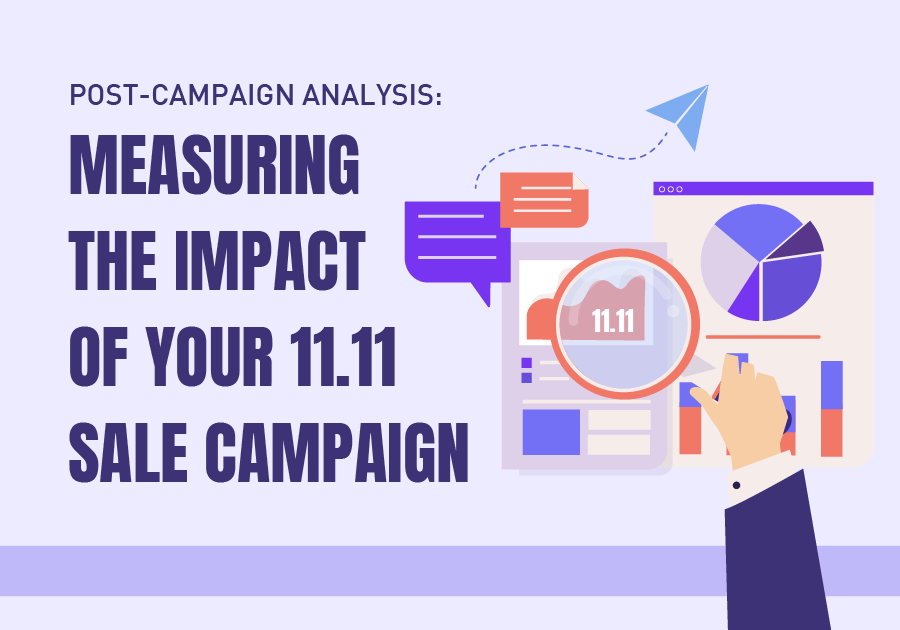In the world of e-commerce, 11.11, also known as Singles’ Day, has evolved into one of the biggest shopping events globally. Originating in China, it has gained international recognition as a day for online shopping extravaganzas. E-commerce businesses across the globe eagerly participate in 11.11 sales campaigns, offering enticing discounts to boost sales. However, the real success of a campaign lies in the post-campaign analysis – a critical step that helps businesses understand their performance, learn from the past, and refine their strategies for the future. In this article, we’ll explore the importance of post-campaign analysis and how to measure the impact of your 11.11 sale campaign effectively.
Why Post-Campaign Analysis Matters
Post-campaign analysis is more than just looking at the bottom line; it’s about evaluating the entire campaign to understand what worked, what didn’t, and how to improve for future campaigns. Here are a few reasons why it’s so crucial:
Measuring ROI: Ultimately, every campaign should bring a return on investment (ROI). Post-campaign analysis helps determine whether the resources invested in your 11.11 sale campaign translated into revenue and profit.
Optimising Strategy: By understanding what worked and what didn’t, you can refine your strategies. This could involve tweaking your pricing, refining your ad placements, or improving your messaging to better resonate with your target audience.
Customer Insights: Analyzing the campaign’s data can provide invaluable insights into customer behavior, preferences, and shopping patterns. This knowledge can be used to tailor your offerings and customer experience.
Competitive Advantage: Post-campaign analysis allows you to stay competitive by keeping track of your performance against industry standards and benchmarks.
Measuring the Impact of Your 11.11 Sale Campaign
Now that we understand why post-campaign analysis is crucial, let’s delve into how to measure the impact of your 11.11 sale campaign effectively:
Set Clear KPIs: Before launching your campaign, establish key performance indicators (KPIs). These could include sales revenue, customer acquisition cost, conversion rate, and customer lifetime value. Having defined KPIs will make it easier to measure success.
Collect Data: Use analytics tools to gather data on various aspects of your campaign, such as website traffic, sales conversion rates, click-through rates on ads, and the behavior of visitors on your site during the campaign period. Make sure your tracking and analytics are set up correctly before the campaign.
Segment Data: Divide your data into different segments to gain deeper insights. Look at the performance of specific products or product categories, customer demographics, referral sources, and geographic regions. This segmentation can help you identify what performed well and what didn’t.
Compare with Benchmarks: To understand how well you performed, compare your campaign results with industry benchmarks and your own historical data. This will help you gauge whether your performance was exceptional or lacking in comparison to others.
Customer Feedback: Don’t forget to gather feedback from customers. Conduct surveys or analyze customer reviews to understand their perceptions of the campaign and your offerings. This qualitative data can be invaluable for making improvements.
Financial Metrics: Assess the financial metrics, such as gross profit margin, average order value, and return on ad spend (ROAS). These will provide a clear picture of the campaign’s impact on your bottom line.
A/B Testing: If you ran multiple variants of your campaign (different ad creatives, landing pages, or offers), perform A/B testing to identify which elements were more effective. This information can guide future campaign decisions.
Learn from Mistakes: Don’t be afraid to acknowledge mistakes or areas where you fell short. Learning from failures is just as important as celebrating successes. Use this information to adjust your strategy for the next campaign.
In the world of e-commerce, post-campaign analysis is a fundamental step in understanding the true impact of your 11.11 sale campaign. It’s not just about counting the revenue; it’s about learning, adapting, and improving for the future. By setting clear KPIs, collecting and segmenting data, and comparing your results with benchmarks, you can gain valuable insights into your campaign’s performance. Don’t forget to listen to customer feedback and be open to making necessary adjustments. With a well-executed post-campaign analysis, you’ll be better equipped to succeed in the ever-competitive e-commerce landscape.


